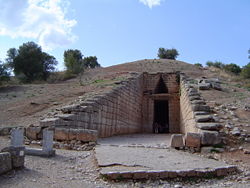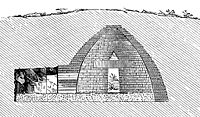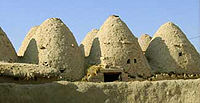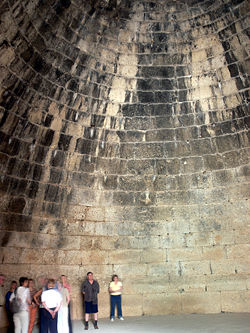Difference between revisions of "Beehive tomb" - New World Encyclopedia
| Line 29: | Line 29: | ||
===Oman=== | ===Oman=== | ||
| − | The earliest stone-built tombs which can be called 'beehive', are in [[Oman]], built of stacked flat stones which occur in nearby geological formations. They date to between 3,500 and 2,500 years B.C.E., to a period when the Arabian peninsula was subject to much more rainfall than now, and supported a flourishing civilization in what is now desert, to the west of the mountain range | + | The earliest stone-built tombs which can be called 'beehive', are in [[Oman]], built of stacked flat stones which occur in nearby geological formations. They date to between 3,500 and 2,500 years B.C.E., to a period when the Arabian peninsula was subject to much more rainfall than now, and supported a flourishing civilization in what is now desert, to the west of the mountain range along the Gulf of Oman. No burial remains have ever been retrieved from these 'tombs', though there seems no other purpose for their building. They have only superficial similarities with the Aegean tombs (circular shape) as they are built entirely above ground level and do not share the same tripartite structure - the entrances are usually an undifferentiated part of the circular walling of the tomb. |
===Thracian tomb of Kazanlak=== | ===Thracian tomb of Kazanlak=== | ||
| − | Not far from the ancient [[Thracian civilization|Thracian]] capital [[Seuthopolis]], in [[Bulgaria]], lies the famous brick beehive tomb of Kazanlak. Situated within a [[necropolis]], the tomb is composed of a narrow corridor and vaulted burial chamber, decorated with murals of ritual funeral feasts.<ref>(1997) World Heritage Site. [[http://www.worldheritagesite.org/sites/kazanlak.html"Thracian tomb of Kazanlak"]] Retrieved September 5, 2007 </ref>. Dating back to the | + | Not far from the ancient [[Thracian civilization|Thracian]] capital [[Seuthopolis]], in [[Bulgaria]], lies the famous brick beehive tomb of Kazanlak. Situated within a [[necropolis]], the tomb is composed of a narrow corridor and vaulted burial chamber, decorated with murals of ritual funeral feasts.<ref>(1997) World Heritage Site. [[http://www.worldheritagesite.org/sites/kazanlak.html"Thracian tomb of Kazanlak"]] Retrieved September 5, 2007 </ref>. Dating back to the fourth century B.C.E., the site is similar to the one in Oman in that it the similarities with Aegean beehive tombs are minimal. This may due in part to the idea that beehive tomb designs did not necessarily originate in Greece, but are common phenomena in other parts of the world. |
==Notes== | ==Notes== | ||
Revision as of 02:33, 15 September 2007
Beehive tombs, also known as Tholos tombs (plural tholoi), are a monumental Late Bronze Age development of the Mycenaean Civilization, that eventually replaced the old style of chamber tombs. It was named such after the vaulted dome shape of the main burial chamber that resembles the shape of a beehive. The change in burial styles has been a significant development in archaeology for it signifies a shift in ancient Greek society.
Description
Most often, beehive tombs were placed underground, either built lowly into the side of a hill, or, in areas with flat parcels of land, entirely subterranean. In the case of the latter, if any part of the structure protruded above the ground it was carefully covered using earth that was held in place by a retaining wall[1] Inside, they were built as corbelled arches, layers of stone placed closer together as the arch tapers toward the top of the tomb. The tombs usually contained more than one burial, in various places in the tomb either on the floor, in pits and cists or on stone-built or rock-cut benches, and with various grave goods.
The tripartite structure of the tombs is not always evident in the earliest mainland examples (for example at Voidhokoilia) but by the time the architectural type had left Messenia the separation into chamber, stomion and dromos was fixed. The chamber is always built in masonry, even in the earliest examples, as is the stomion or entrance-way, which provided an opportunity for conspicuous demonstration of wealth. The dromos was often just cut from the bedrock, even in some of the earlier examples at Mycenae itself. In later examples, all three parts were constructed of fine ashlar masonry.
Origins
The oldest beehive tomb discovered thus far is in Messenia. Previously, the Minoan style of burial, the chamber tomb, had been the most frequent style used, from about 1600 B.C.E. to 1100 B.C.E., due probably to the large influence the Minoans had over the Aegean region at the time. After about 1500 B.C.E., beehive tombs became more widespread, suggesting to many archaeologists that the influence of the Minoans was in decline. From Messenia, the beehive tomb spread to other areas of Greece, particularly Argolid, Laconia, and Attica.[2]
Archaeological Significance
Treatment of the dead has long been one avenue in which archaeologists have been able to glimpse the mentality of long gone civilizations. Developments in tomb structures usually correlate to developments in society.[3] Hence, while why the switch from chamber to beehive tombs took place remains a contention among archaeologists, there are nonetheless many implications arising from the change. As beehive tombs became more popular in Greece, they began to become regulated to the highest class of citizens; usually royalty and the highest non-royalty bureaucrats and their families were only entombed in beehive structures. This suggests that there was a strict social stratigraphy in Greece at the time. The infrequency of later beehive tombs also indicates the eventual consolidation of power in Greece, as the once city states became larger conglomerates, requiring fewer beehive tombs for the fewer persons with power.[4]
The beehive tomb design for the most stayed within Greece. However, there are examples of similar designs from around the world, although it is not clear if they were culturally defused from Greece, or if they were concurrently separated phenomena.
Famous Examples
Treasury of Atreus
Perhaps the most famous beehive tomb in Greece is the Treasury of Atreus, sometimes called the Tomb of Clytemnestra, located in Mycenae, Greece (on the Panagitsa Hill) constructed around 1250 B.C.E. The name of the tomb is misleading for no one is exactly sure who was meant to be entombed in the chamber, and no artifacts have been recovered there. Due to the impressive size and exact masonry of the tomb, it is assumed that it was built for a king who would have been likely buried with treasures and weapons, yet none have been discovered at the site. Yet, it remains one of the most impressive burial structures in Greece, and was the tallest and widest dome in the world for over a thousand years until construction of the Temple of Mercury in Baiae.[5]
Oman
The earliest stone-built tombs which can be called 'beehive', are in Oman, built of stacked flat stones which occur in nearby geological formations. They date to between 3,500 and 2,500 years B.C.E., to a period when the Arabian peninsula was subject to much more rainfall than now, and supported a flourishing civilization in what is now desert, to the west of the mountain range along the Gulf of Oman. No burial remains have ever been retrieved from these 'tombs', though there seems no other purpose for their building. They have only superficial similarities with the Aegean tombs (circular shape) as they are built entirely above ground level and do not share the same tripartite structure - the entrances are usually an undifferentiated part of the circular walling of the tomb.
Thracian tomb of Kazanlak
Not far from the ancient Thracian capital Seuthopolis, in Bulgaria, lies the famous brick beehive tomb of Kazanlak. Situated within a necropolis, the tomb is composed of a narrow corridor and vaulted burial chamber, decorated with murals of ritual funeral feasts.[6]. Dating back to the fourth century B.C.E., the site is similar to the one in Oman in that it the similarities with Aegean beehive tombs are minimal. This may due in part to the idea that beehive tomb designs did not necessarily originate in Greece, but are common phenomena in other parts of the world.
Notes
- ↑ (2000) Prehistoric Archaeology of the Aegean Project. ["Lesson 19: Mycenaean Tholos Tombs and Early Mycenaean Settlements"] Dartmouth College, Retrieved September 5, 2007
- ↑ (2000) Prehistoric Archaeology of the Aegean Project. ["Lesson 19: Mycenaean Tholos Tombs and Early Mycenaean Settlements"] Dartmouth College, Retrieved September 5, 2007
- ↑ (2000) Renfrew, Colin and Paul Bahn "Archaeology: Theories, Methods and Practice" (3rd Edition) Thames and Hudson. ISBN 0500281475
- ↑ (2000) Prehistoric Archaeology of the Aegean Project. ["Lesson 19: Mycenaean Tholos Tombs and Early Mycenaean Settlements"] Dartmouth College, Retrieved September 5, 2007
- ↑ (2007) Duckeck, Jochen. ["The Treasury of Atreus - Tomb of Clytemnestra"] Retrieved September 5, 2007
- ↑ (1997) World Heritage Site. ["Thracian tomb of Kazanlak"] Retrieved September 5, 2007
ReferencesISBN links support NWE through referral fees
- Castleden, Rodney. 2005. Myceneans: Life in Bronze Age Greece. Routledge. ISBN 0415363365
- Dickinson, Oliver. 1994. The Aegean Bronze Age. Cambridge University Press. ISBN 0521456649
- Mylonas, George Emmanuel. 1966. Mycenae and the Mycenaean Age. Princeton University Press. ISBN 0691035237
External links
- Mycenaean tholos tombs paintings
- Treasury of Atreus 360° Interactive virtual tour
- Thracian Beehive Tomb of Kazanlak Retrieved September 14, 2007.
Credits
New World Encyclopedia writers and editors rewrote and completed the Wikipedia article in accordance with New World Encyclopedia standards. This article abides by terms of the Creative Commons CC-by-sa 3.0 License (CC-by-sa), which may be used and disseminated with proper attribution. Credit is due under the terms of this license that can reference both the New World Encyclopedia contributors and the selfless volunteer contributors of the Wikimedia Foundation. To cite this article click here for a list of acceptable citing formats.The history of earlier contributions by wikipedians is accessible to researchers here:
The history of this article since it was imported to New World Encyclopedia:
Note: Some restrictions may apply to use of individual images which are separately licensed.



